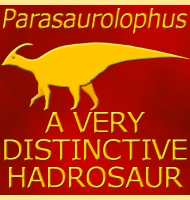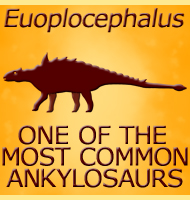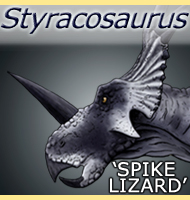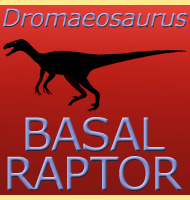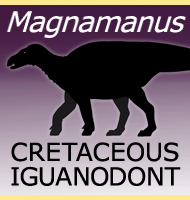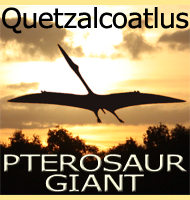


Hypacrosaurus
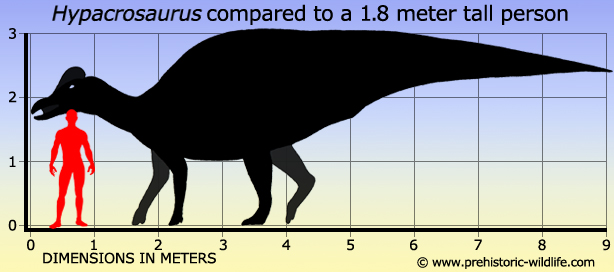
Name:
Hypacrosaurus
(near the highest lizard).
Phonetic: Hie-pak-roe-sore-us.
Named By: Barnum Brown - 1923.
Synonyms: Cheneosaurus.
Classification: Chordata, Reptilia, Dinosauria,
Ornithischia, Ornithopoda, Hadrosauridae, Lambeosaurinae.
Species: H. altispinus
(type), H. stebingeri.
Diet: Herbivore.
Size:Up to 9.1 meters long.
Known locations: Canada - Alberta -
Horseshoe Canyon Formation. USA - Montana - Two Medicine
Formation.
Time period: Campanian to early Maastrichtian of the
Cretaceous.
Fossil representation: Multiple skulls and partial
post cranial remains. Eggs and Juvenile specimens also known.
Hypacrosaurus
means ‘near the highest lizard’, and in this context the
‘lizard’ was actually the dinosaur Tyrannosaurus,
one of the
largest dinosaurs in the ecosystems of late Cretaceous North America,
but only about a third larger than Hypacrosaurus
in the largest
individuals (twelve meters for large individual Tyrannosaurus
compared to nine meters for Hypacrosaurus).
Interestingly
Hypacrosaurus and other dinosaurs like it may have
actually been prey
to Tyrannosaurus and other related genera such as Albertosaurus.
Evidence for this comes from a huge bite wound inflicted to the back
of an Edmontosaurus
that closely matches the shape of a Tyrannosaurus
mouth. Because the bones in the wound actually healed afterwards,
this proves that the Edmontosaurus in question was
alive when it
happened, and not a case of a tyrannosaur
simply scavenging an
existing carcass.
The
type species name of H. altispinus is a reference
to the tall neural
spines of the vertebrae. These tall spines would have significantly
increased the height of the body and may have been to facilitate a
display function, fat storage for leaner times, to perhaps being to
help with activities for swimming (as has been proposed for
Magnapaulia).
H. stebingeri is significantly important since
this
is so far made up from the remains of juveniles and eggs that when
combined with data from other hadrosaurid
genera such as Maiasaura,
allows for a serious insight into how these kinds of dinosaurs
reproduced and grew up.
Juvenile
fossils display growth rings when examined in cross section (similar
to what you can see in a tree stump) that indicate Hypacrosaurus
achieved reproductive maturity in as little as two to three years while
reaching full size in ten. This is significantly faster than in their
potential predators the tyrannosaurs. Studies of these dinosaurs show
that for the first ten years of a tyrannosaurs life growth would be
pretty slow with the individual remaining small. Then in years ten to
twenty, growth would rapidly accelerate until the individual reached
almost full size and reproductive maturity, before a further ten
years of slow and steady growth. To put this in perspective, in the
twenty years it took for one generation of Tyrannosaurus
to potentially
pass, at least six generations of Hypacrosaurus
could have happened.
When
you compare this to the twenty of so eggs in each Hypacrosaurus
nest,
you get the conclusion that Hypacrosaurus were
breeding at a rate to
compensate for high mortality levels. Assuming that environmental
conditions were not so much of a factor, this could be because
Hypacrosaurus was a viable and common prey species
of the time, and tyrannosaurs
withstanding, other predators of Hypacrosaurus
may have
included troodontids like Troodon.
These small predators would have
been a particular threat to the smaller individuals of Hypacrosaurus,
reducing the numbers growing to adult hood.
The
crest of Hypacrosaurus is similar to that of its
relative
Corythosaurus,
though wider and not as high. This crest was also
hollow which confirms its establishment as a lambeosaurine hadrosaurid
(the group typified by Lambeosaurus).
Several theories have been
made about the function of lambeosaurine head crests, though the one
with the most support concerns visual display so that different species
of hadrosaur can tell each other apart, probably in a similar fashion
to how the differences in the forms of horns and neck frills allow
different genera of ceratopsian
dinosaurs to be identified.
A
theory more specific to lambeosaurine hadrosaurids however concerns the
possibility that the hollowness of the crest may in fact be a
resonating chamber for amplifying calls. Again the differences in
crest form between different lambeosaurine genera could have produced
different levels of amplification, and hence different sounding call
specific to a distinct species. Although the resonating chamber
theory is not supported by all palaeontologists, it is one that is
still interesting in itself.
It
has already been said that Hypacrosaurus was
similar in form to
Corythosaurus, but other genera such as Olorotitan
and Nipponosaurus
are also thought to be closely related.
Further reading
- A new trachodont dinosaur, Hypacrosaurus,
from the Edmonton
Cretaceous of Alberta, Barnum Brown - 1913.
- On Cheneosaurus tolmanensis, a new genus and
species of
trachodont dinosaur from the Edmonton Cretaceous of Alberta, Lawrence
M. Lambe - 1917.
- Taxonomic implications of relative growth in lambeosaurine
dinosaurs, Peter Dodson - 1975.
- Growth rate of Hypacrosaurus stebingeri as
hypothesized from lines
of arrested growth and whole femur circumference, L. N. Cooper
& J. R . Horner - 1999.
- First Evidence of Dinosaurian Secondary Cartilage in the
Post-Hatching Skull of Hypacrosaurus stebingeri
(Dinosauria,
Ornithischia), A. M. Bailleul, B. K. Hall &
J.
R. Horner - 2012.
-
Evidence of proteins, chromosomes and chemical markers of DNA in
exceptionally preserved dinosaur cartilage. - National Science Review.
7 (4): 815−822. - Alida M Bailleul, Wenxia Zheng, John R Horner, Brian
K Hall, Casey M Holliday & Mary H Schweitzer - 2020.
Random favourites
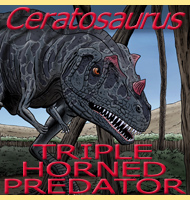 |
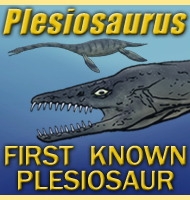 |
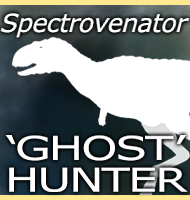 |
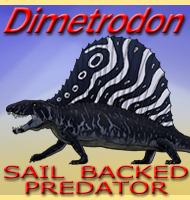 |
